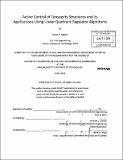| dc.contributor.advisor | Jerome J. Connor. | en_US |
| dc.contributor.author | Nelson, Karen E. (Karen Elizabeth), M. Eng. Massachusetts Institute of Technology | en_US |
| dc.contributor.other | Massachusetts Institute of Technology. Dept. of Civil and Environmental Engineering. | en_US |
| dc.date.accessioned | 2011-11-01T19:51:51Z | |
| dc.date.available | 2011-11-01T19:51:51Z | |
| dc.date.copyright | 2011 | en_US |
| dc.date.issued | 2011 | en_US |
| dc.identifier.uri | http://hdl.handle.net/1721.1/66845 | |
| dc.description | Thesis (M. Eng.)--Massachusetts Institute of Technology, Dept. of Civil and Environmental Engineering, 2011. | en_US |
| dc.description | Cataloged from PDF version of thesis. | en_US |
| dc.description | Includes bibliographical references (p. 61-62). | en_US |
| dc.description.abstract | The concept of responsive architecture has inspired the idea structures which are adaptable and change in order to better fit the user. This idea can be extended to structural engineering with the implementing of structures which change to better take on their external loading. The following text explores the utilization of active control for tensegrity systems in order to achieve an adaptable structure. To start, a background of the physical characteristics of these structures is given along with the methods which are used to find their form. Next, the different methods which have been previously used to achieve active control in tensegrity are reviewed as well as the objectives they intended to achieve. From there, the Linear Quadratic Regulator (LQR) algorithm is introduced as a possible method to be used in designing active control. A planar tensegrity beam is described, whose form was found by the force density method. A simulation is then conducted, which applies the LQR algorithm to this structure for the purposes of active control. This simulation served both to demonstrate the force density and LQR methods, as well as to study how different control parameters and actuator placements effects the efficiency of the control. This text concludes with a discussion of the results of this simulation. | en_US |
| dc.description.statementofresponsibility | by Karen E. Nelson. | en_US |
| dc.format.extent | 88 p. | en_US |
| dc.language.iso | eng | en_US |
| dc.publisher | Massachusetts Institute of Technology | en_US |
| dc.rights | M.I.T. theses are protected by
copyright. They may be viewed from this source for any purpose, but
reproduction or distribution in any format is prohibited without written
permission. See provided URL for inquiries about permission. | en_US |
| dc.rights.uri | http://dspace.mit.edu/handle/1721.1/7582 | en_US |
| dc.subject | Civil and Environmental Engineering. | en_US |
| dc.title | Active control of tensegrity structures and its applications using Linear Quadratic Regulator algorithms | en_US |
| dc.type | Thesis | en_US |
| dc.description.degree | M.Eng. | en_US |
| dc.contributor.department | Massachusetts Institute of Technology. Department of Civil and Environmental Engineering | |
| dc.identifier.oclc | 757938032 | en_US |
